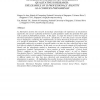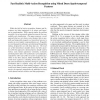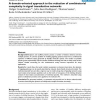1507 search results - page 87 / 302 » Separating Complexity Classes Using Structural Properties |
ECIS
2004
13 years 11 months ago
2004
As Information Systems (IS) research increasingly acknowledges the importance of non-positivist approaches, the case for a plurality of theories to guide qualitative studies has g...
IFL
2001
Springer
14 years 2 months ago
2001
Springer
Abstract. Generic programming enables the programmer to define functions by induction on the structure of types. Defined once, such a generic function can be used to generate a s...
ICCV
2009
IEEE
13 years 7 months ago
2009
IEEE
Within the field of action recognition, features and descriptors are often engineered to be sparse and invariant to transformation. While sparsity makes the problem tractable, it ...
ICALP
2009
Springer
14 years 10 months ago
2009
Springer
Abstract. Tile sets and tilings of the plane appear in many topics ranging from logic (the Entscheidungsproblem) to physics (quasicrystals). The idea is to enforce some global prop...
BMCBI
2006
13 years 10 months ago
2006
Background:Receptors and scaffold proteins possess a number of distinct domains and bind multiple partners. A common problem in modeling signaling systems arises from a combinator...



